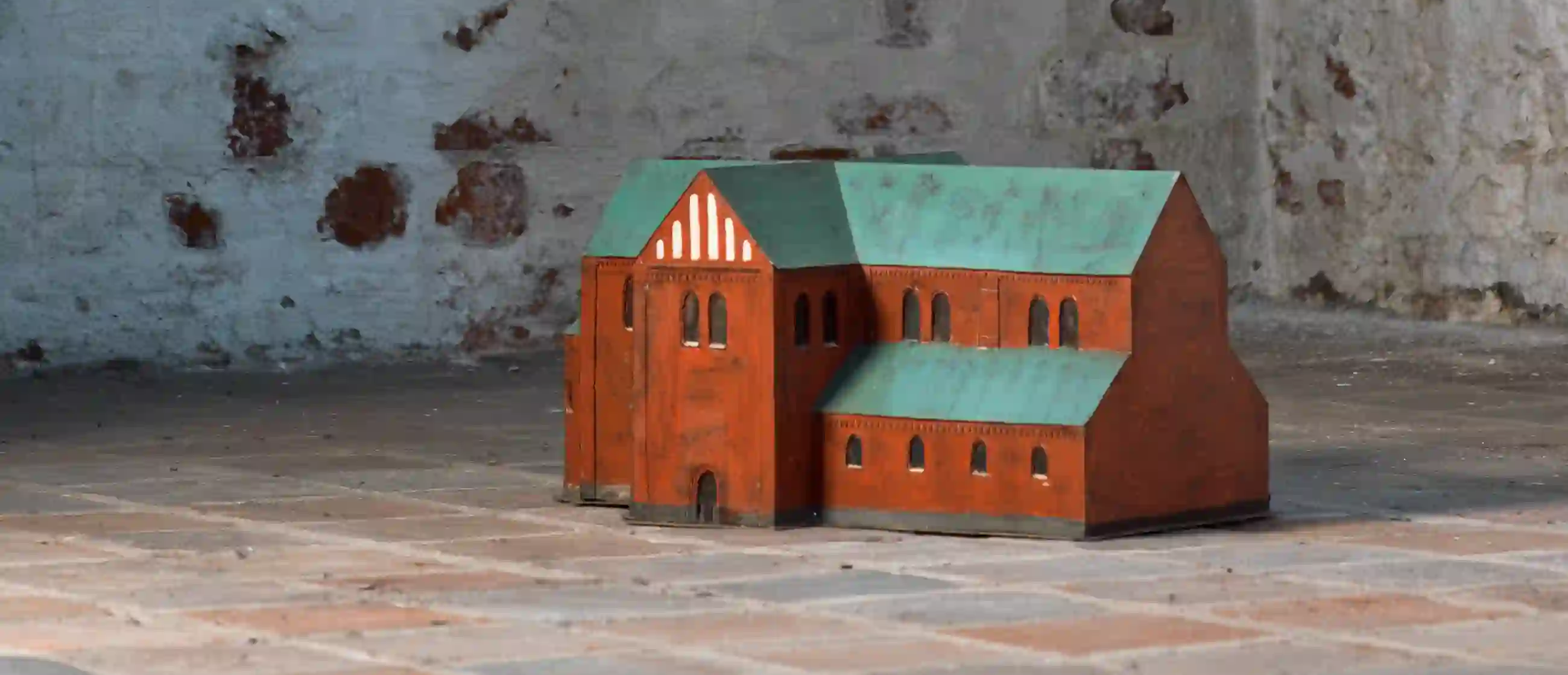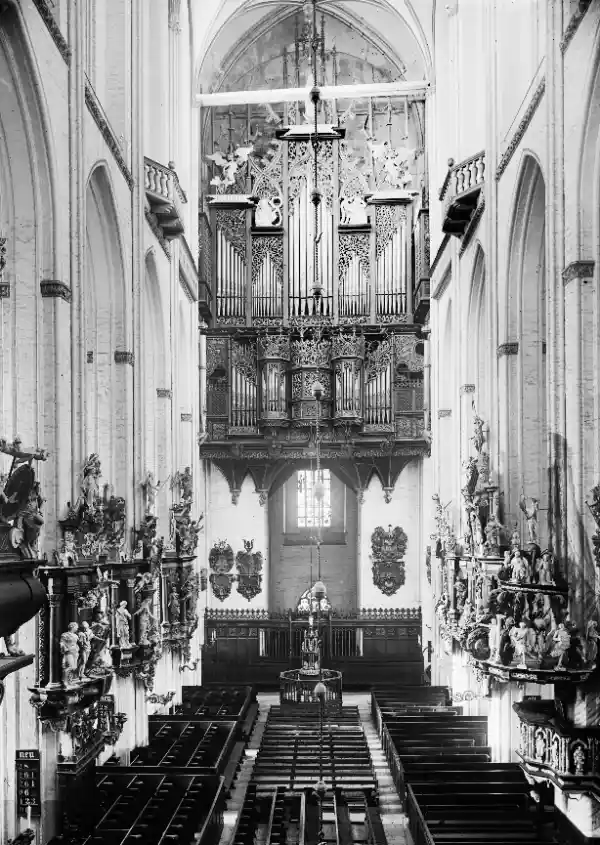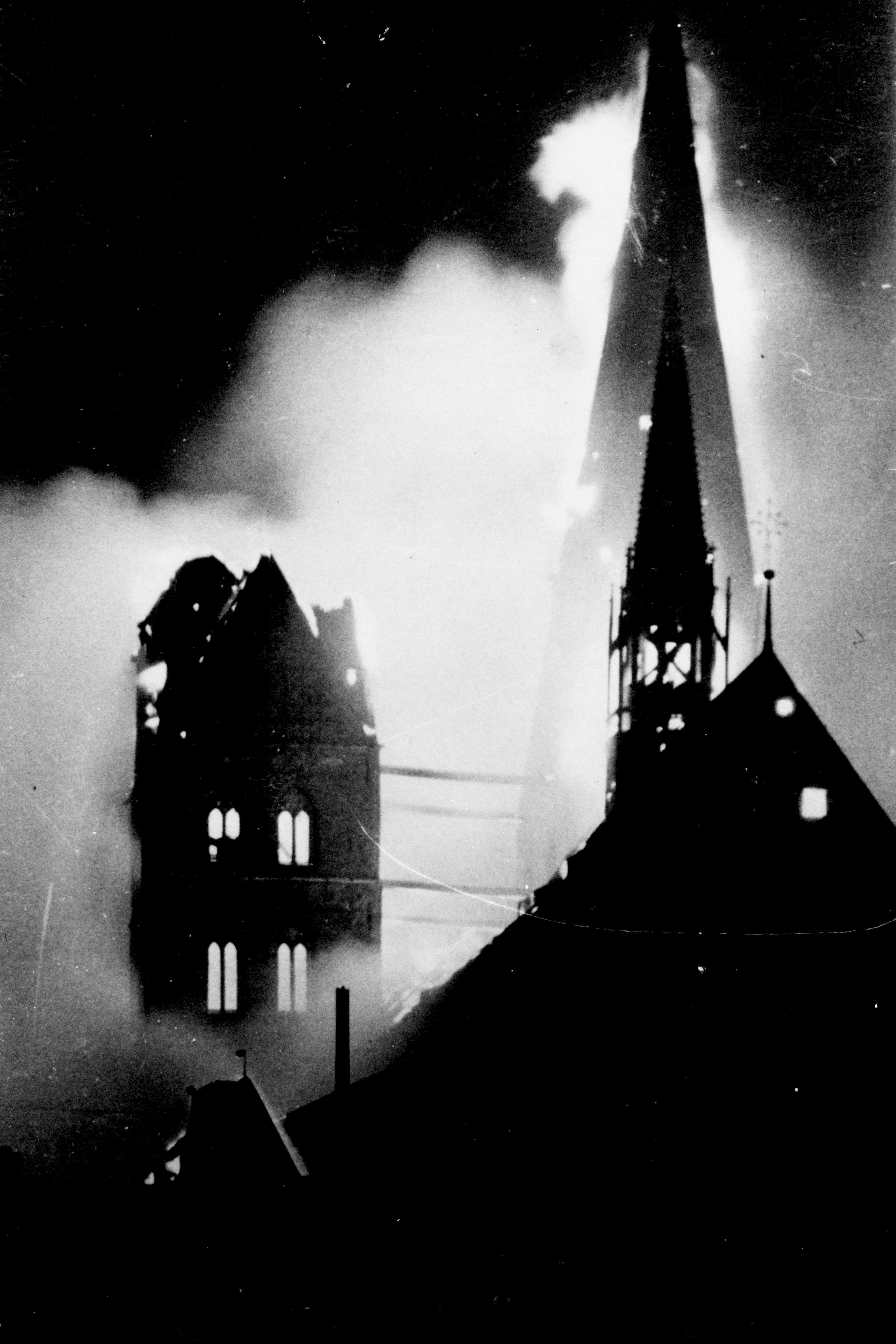Eight eventful centuries
St Marien through the ages
Like few other churches, St Marien embodies the history of several eras. Here, miracles and wounds lie close together.
A church in the making
Middle Ages
The origins of St Marien are closely linked to the origins of the city of Lübeck. As early as 1160, shortly after the city was founded on its present site, there was a market church. Initially, it was the only parish church in the city. No one knows today what it looked like. It was probably made of wood.
Lübeck became a bishopric in 1160. With the consecration of the first cathedral in 1163, St Marien was placed under the authority of the canons. The city council fought for a say in matters early on. St Marien (or "Marienkirche" as everyone calls it) remained the church of the leading citizens and the council, even after the other parish churches in the city were founded.
At the beginning of the 13th century, the church was a Romanesque basilica.
In 1251, reconstruction began in the style of a Gothic cathedral. Initially, a hall church was planned, but then a high Gothic basilica of enormous dimensions was built. At a height of 38.5 metres, the vaults span the impressive central nave, and the two towers reach a height of 125 metres.
The great French cathedrals, above all those of Reims and Soissons, served as models. However, this meant that Lübeck's master builders had to reinvent the Gothic style in a certain way. There were no significant quarries in the North German plains. The mighty, towering forms of Gothic architecture had to be realised here using small bricks fired from clay.
At the beginning of the 14th century, the citizens and the bishop were locked in constant dispute. The fact that the citizens of Lübeck believed they could build it, and that they ultimately succeeded in constructing a brick church whose size surpassed that of the nearby cathedral, shows just how self-confident and wealthy these citizens were in the 13th and 14th centuries.

A church in transition
Reformation
The Reformation reached Lübeck relatively late. Johannes Fritze, chaplain at St Marien, was one of the first preachers to publicly profess his support for the new movement in 1523. The canons dismissed him from his post, and he left for Hamburg. However, the Protestant movement among the citizens could not be suppressed. This resulted in a so-called "singing war", in which Catholic masses were interrupted by the loud singing of Reformation psalm songs.
At the end of 1529, the council and cathedral chapter were forced to reverse the dismissal of the popular Protestant chaplain Johannes Walhoff at St Marien. In 1530, the Reformation prevailed in Lübeck with the church order of Johannes Bugenhagen. This also led to much greater participation by the citizens in the government of the city.
The Reformation changed the interior of the church, but not as violently as in other regions.
Not all, but many images and figures were removed from it: the statues of Mary in the choir and the many images that adorned the letter chapel. The most visible evidence of the Reformation was the new pulpit from 1534, which was decorated with elaborate reliefs and Low German sayings. Worship and sermons now took place only in the nave and choir, and no longer, as before, in the many side chapels with their secondary altars. Despite the discontinuation of the worship of Mary, the church retained its name.

A church undergoing transformation
Modern Era
In the 17th and 18th centuries, the citizens designed their "Marienkirche", as far as the building allowed, according to Baroque ideals. The walls were whitewashed, and a myriad of magnificently designed epitaphs of leading citizens hung on the pillars of the naves. This earned the church the slightly derisive title of "Hall of Fame of the Lübeck Patriciate".
The close connection between the council and the church began to weaken in the 18th century. In the 19th century, part of the Baroque furnishings fell victim to the newly awakened appreciation of medieval art.
Shortly after the National Socialists came to power, the city senate dissolved the Lutheran Church in Lübeck and stripped the church councils of their powers – including that of St Marien. In 1934, the National Socialist Erwin Balzer was appointed bishop. St Marien was his official preaching church. The pastor of St Marien, Johannes Pautke, who belonged to the opposition Confessing Church, was temporarily removed from office between 1936 and 1937, but was able to return after fierce protests.

A church is being destroyed
Palm Sunday 1942
On the night of 28 to 29 March 1942, Palm Sunday, British bombers attacked Lübeck. It was the first attack on a German old town. The church was severely damaged. Parts of the vaults of the central nave and aisles collapsed, as did the roofs of the towers.
The bells of the south tower fell and destroyed the medieval window panes that were stored there in boxes. The old organs burned. The medieval inventory of the church was almost completely destroyed.

A church is being rebuilt
From 1945 to the present day
When the church burned down, most of the plaster fell off the walls. Surprisingly, this revealed the original medieval paintings in the church. These were documented in photographs during the war. After the war, they were restored. This led to conflicts between monument conservators and restorers. The monument conservators only allowed additions to the preserved originals within very narrow limits. The restorers took considerable liberties.
One of them, Lothar Malskat, achieved dubious fame in the process: he painted fictitious figures on the walls of the choir. Malskat, who considered himself a brilliant forger and artist, turned himself in in 1952 and became a media star, especially since he skilfully exaggerated his deeds. The forgeries in the choir were removed shortly afterwards.
Most of the reconstruction was completed in 1959, when the spires were restored and covered with copper. In 1980, St Marien was given a ridge turret again.
In 1971, almost 30 years after the destruction of the war, St Marien became a member of the Community of the Coventry Cross of Nails.
The towers of the church underwent extensive renovation work until 2021 to prevent further damage.
In 2022, the Great Organ (Kemper Organ) was decommissioned and dismantled in 2025.
The passage of time, material deficiencies during reconstruction and outdated infrastructure make it necessary to comprehensively renovate the vaults and windows. This is to be completed by 2030 and will be financed half by the federal government and half by generous donations.



